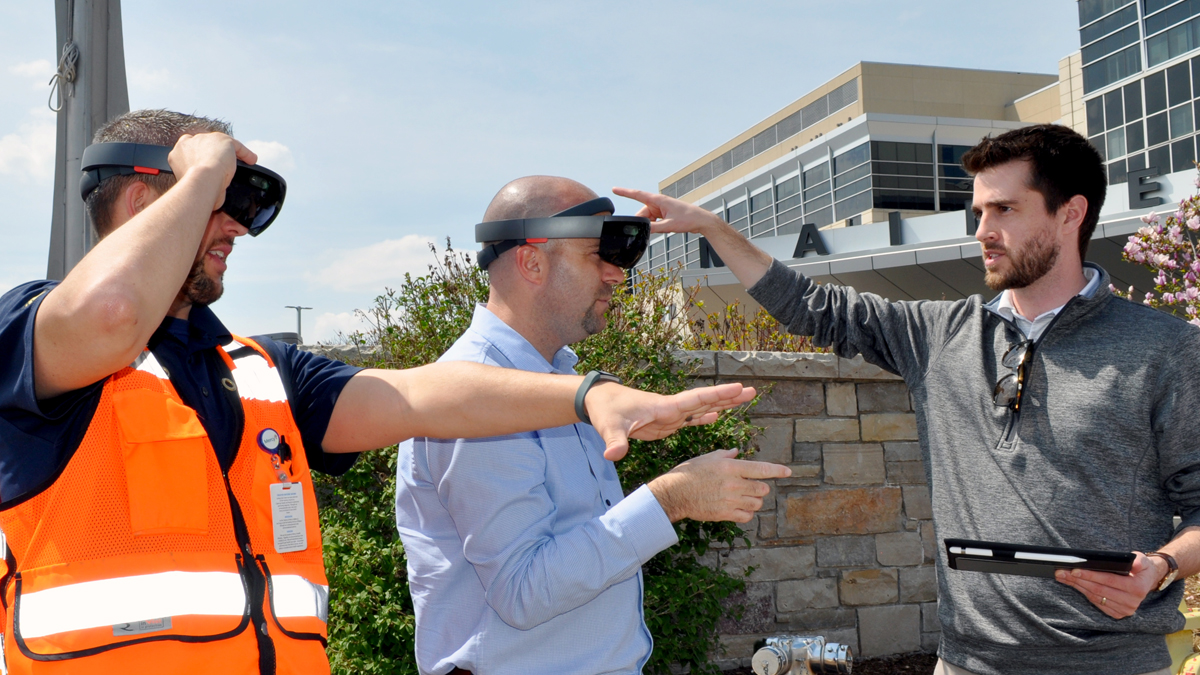
The ability to see through a building’s walls, floors and ceiling is no longer just a comic-book fantasy, thanks to the growing accessibility of mixed-reality technology. This X-ray vision enables construction teams to peel back layers of a BIM model so they can accurately view a building’s structure and systems.
But for professionals who deliver infrastructure and sitework services, mixed reality also has the potential to connect them to the underground world.
A fundamental part of sitework involves knowing what’s buried beneath a jobsite, and that information is not verifiable without utilizing both costly locating technologies and commissioning a land surveying company. Otherwise, project teams are challenged to identify visible site features and approximate where utility lines are buried. The process is imprecise and inefficient.
To tackle this challenge, Castle Contracting implements a customized approach, incorporating subsurface utility mapping to develop a detailed 3D Civil Information Model (CIM) that accurately portrays underground utility alignments and locations. To help visualize the model and take it into the field, the Castle team is currently exploring an innovative approach to portraying utility lines on a project site using the Microsoft HoloLens, a head-mounted mixed-reality display. Because a project’s CIM models are built into the display, team members can use the device to quickly view what’s buried under the surface of a construction site in real time, in real space.

Implementing this technology in the field involves precisely placing anchor points in strategic locations throughout the site. When someone selects an anchor point, the HoloLens will display the utility map for that location, superimposed on the ground in real-life dimensions.
The HoloLens helps the client and project team better visualize and understand site-specific conditions, subsurface conflicts, design challenges, and constructability. Unlike a 20-scale drawing, mixed reality provides individuals with an accurate 1:1 depiction of what’s buried underground and a truly immersive experience.
In addition to the head-mounted HoloLens, mobile applications have been developed to visualize these same civil information models using handheld mobile platforms such as tablets and phones. Using the camera within the device, these models can be viewed in real space using the same site anchors that are used for the HoloLens. With the widespread availability of capable mobile devices, this can be a very beneficial and efficient option.
Either method can help guide project teams to avoid the spider web of buried utility lines. These hazards are most challenging on congested or dense urban sites, where the utilities infrastructure may have been installed over a period of many decades, often with incomplete or inaccurate records available.
Because the approach is hardware-agnostic, it can be adapted to future ways of integrating mixed reality on a jobsite—whether that’s via a tablet, a smartphone or a pair of voice-activated sunglasses.

Beyond providing construction teams with accurate data to avoid hazards and avert expensive project delays, mixed reality also has the potential to equip facilities personnel and other stakeholders with “living” data for use in future maintenance and expansion projects. It makes infrastructure and sitework much more tangible and accessible to anyone who doesn’t spend each day looking at engineering drawings.
Though these explorations are just scratching the surface for what this technology can offer, the approach represents a quantum leap forward for civil contractors and the entire construction process.
This article was brought to you through the BuiltWorlds Thought Leadership Contributor Program.
Enrico Bertucci, P.E., is a director at McCarthy Building Companies and Matthew Fitzgerald, P.E., is project manager at Castle Contracting, LLC, a McCarthy sister company that provides turnkey site preparation services, site utilities, earthwork, subsurface utility mapping and trenchless technology directly to owners; general contractors; and mechanical, electrical, plumbing and fire protection contractors.

Discussion
Be the first to leave a comment.
You must be a member of the BuiltWorlds community to join the discussion.